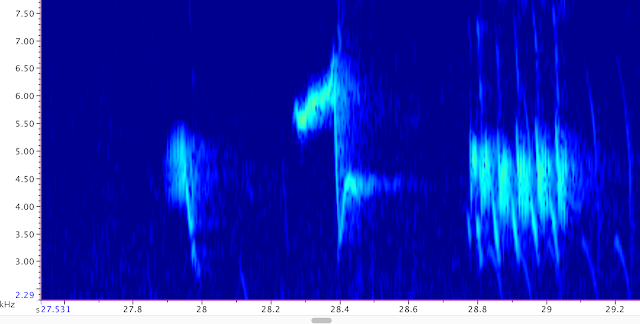The last couple of weeks have been manic at work with some very early starts for breeding bird surveys, late nights reviewing documents and getting the company ready for the new and extremely tedious General Data Protection Regulations which come into force later in May. However, I have managed to get out a little to protect my sanity.
On the morning of 16th May I visited Marin Down on the north Hampshire and Wiltshire border to complete my Nightingale survey as organised by the Hampshire and Isle of Wight Wildlife Trust, alas, there were no Nightingale.
Martin Down has experienced a catastrophic fall in population from 24 singing males in 1980 to none now, there cannot have been a change in the extent of scrub, this is a National Nature Reserve and there has probably been an increase rather than a reduction in scrub cover.

So surely this local and the national decline is linked to changes in the wintering grounds or something happening along the migration routes rather than localised habitat loss/change in the UK. Still, there were lots of Corn Bunting (at least 15 birds recorded) and the first Turtle Dove that I have seen in the UK for many years with at least six ‘purring’ birds.
Here, also were an amazing density of Skylark and it was difficult to estimate the number of birds but my best guess was 30 birds in all. It was a little windy for butterflies and the only species I recorded was a single Green Hairstreak, my first of the year.
Corn Bunting – Martin Down, Hampshire
Corn Bunting – Martin Down, Hampshire
Turtle-dove – Martin Down, Hampshire
The gentle purring of Turtle-dove is a classic summer sound which is fast disappearing from the UK countryside – Martin Down, Hampshire
Green Hairstreak – Martin Down, Hampshire
Invertebrate surveys with Adam Wright on 17th May near to Fishbourne, Chichester area produced a few first spring records for me although we recorded nothing of great excitement. White-legged Damselfly, Beautiful Demoiselle, Banded Demoiselle and Hairy Hawker were nice species to see as always.
The hoverfly Platycheirus rosarum – Fishbourne, Chichester
The hoverfly Helophilus pendulus – Fishbourne, Chichester
The hoverfly Cheilosia albitarsus – Fishbourne, Chichester
The snipefly Rhagio scolopacea – Fishbourne, Chichester
On 18th May I had a short wander around Pennington Marsh, it was fairly quiet with the highlights being two male Ruff almost in summer plumage, 25 Dunlin, two Peregrine over the site, three Whimbrel, 15 Great-crested Grebe (this seemed to be a large number for a May visit) and two very late Wigeon. Numbers of migrant birds seem to be very low and I only recorded three Whitethroat and four Reed Warbler of the breeding species. Singles of Cuckoo and a Lesser Whitethroat seemed to be birds holding territory on site.
Reed Warbler – Pennington Marsh, Hampshire
Song of Reed Warbler (the bird photographed above) – Pennington Marsh, Hampshire
Long song sequence of Reed Bunting, a lazy mid-summer sound of wetland habitats, reeds can be heard rustling in this recording – Pennington Marsh, Hampshire
Single song sequence of Reed Bunting – Pennington Marsh, Hampshire
Lesser Whitethroat – Pennington marsh, Hampshire
The typical song of Lesser Whitethroat with a rattle followed by harsh warbling notes – Pennington Marsh, Hampshire
Sequence of Lesser Whitethroat song with a rattle to begin with followed by warbling notes – Pennington Marsh, Hampshire
Sequence of Lesser Whitethroat song starting with the rattle then a sequence of warbling notes and ending in a rattle – Pennington Marsh, Hampshire
Simon Colenutt
I began birdwatching at the age of nine when living on the Isle of Wight. After obtaining a copy of the Isle of Wight Bird Report from 1976 I realised that Manx Shearwater, Arctic Skua, Pomarine Skua and Black Tern were regularly seen at St.Catherine's Point, only five miles from my home village of Chale Green. To a nine year old these birds were near mythical and so I just had to go and try to see them. Little did I know that these birds were seasonal and after a long winter of seeing nothing I eventually started to bump into other birdwatchers as March drew to a close. It was then that Dave Hunnybun, Dave Wooldridge, Paul Castle, Peter Gandy and Audrey Wilkinson introduced me to the art of seawatching and the joys of bird migration, I have not looked back since.




















Leave a Reply